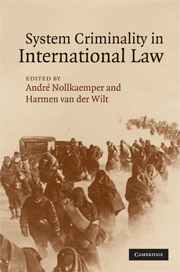Book contents
- Frontmatter
- Contents
- Preface
- Table of cases
- Table of treaties and international instruments
- List of abbreviations
- List of contributors
- 1 Introduction
- 2 The policy context of international crimes
- 3 Why corporations kill and get away with it: the failure of law to cope with crime in organizations
- 4 Men and abstract entities: individual responsibility and collective guilt in international criminal law
- 5 A historical perspective: from collective to individual responsibility and back
- 6 Command responsibility and Organisationsherrschaft: ways of attributing international crimes to the ‘most responsible’
- 7 Joint criminal enterprise and functional perpetration
- 8 System criminality at the ICTY
- 9 Criminality of organizations under international law
- 10 Criminality of organizations: lessons from domestic law – a comparative perspective
- 11 The collective accountability of organized armed groups for system crimes
- 12 Assumptions and presuppositions: state responsibility for system crimes
- 13 State responsibility for international crimes
- 14 Responses of political organs to crimes by states
- 15 Conclusions and outlook
- Index
5 - A historical perspective: from collective to individual responsibility and back
Published online by Cambridge University Press: 08 October 2009
- Frontmatter
- Contents
- Preface
- Table of cases
- Table of treaties and international instruments
- List of abbreviations
- List of contributors
- 1 Introduction
- 2 The policy context of international crimes
- 3 Why corporations kill and get away with it: the failure of law to cope with crime in organizations
- 4 Men and abstract entities: individual responsibility and collective guilt in international criminal law
- 5 A historical perspective: from collective to individual responsibility and back
- 6 Command responsibility and Organisationsherrschaft: ways of attributing international crimes to the ‘most responsible’
- 7 Joint criminal enterprise and functional perpetration
- 8 System criminality at the ICTY
- 9 Criminality of organizations under international law
- 10 Criminality of organizations: lessons from domestic law – a comparative perspective
- 11 The collective accountability of organized armed groups for system crimes
- 12 Assumptions and presuppositions: state responsibility for system crimes
- 13 State responsibility for international crimes
- 14 Responses of political organs to crimes by states
- 15 Conclusions and outlook
- Index
Summary
Introductory remarks
The aim of this chapter is to outline the multifaceted and complex relations between state responsibility for grave breaches of peremptory norms of international law and individual responsibility for the same kind of crimes. In order to do so I have privileged a ‘historical perspective’, because it best captures my real intention, which is to show how the idea from which state responsibility originates, namely collective responsibility, although it has been superseded over the course of the centuries by more refined notions, paradoxically still lingers in concepts of both state and individual responsibility to some extent and, therefore, it can be a useful conceptual tool to better understand some of their reciprocal inferences.
Although my chapter will deal with some well known twentieth-Century cases of state and individual responsibility for aggression, war crimes and crimes against humanity, the so-called core crimes of international law, the notion of collective responsibility has been regaining the attention of doctrine also with regard to non-state entities, such as multinational companies or terrorist groups, which attests to its enduring vitality. In that respect, it is a key legal response to situations of system criminality, which are characterized precisely by the collective dimension of individual criminal acts.
In the following sections, I will sketch the traditional view of state responsibility before the First World War (section II), and the naissance of individual responsibility alongside state responsibility in the aftermath of the Second World War (section III).
- Type
- Chapter
- Information
- System Criminality in International Law , pp. 101 - 126Publisher: Cambridge University PressPrint publication year: 2009
- 2
- Cited by



